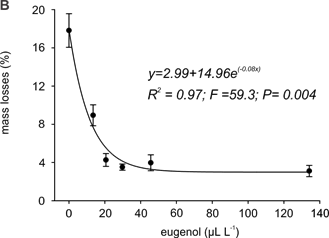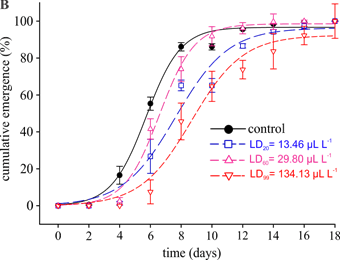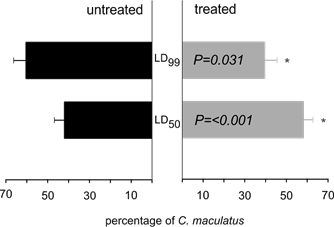INTRODUCTION
Cowpea, Vigna unguiculata L. Walp, is a Leguminosae species widely cultivated in tropical and subtropical countries. With protein content of about 23%-25%, cowpea is a good protein source suitable in the diet of many people in third world countries (Kaliramesh et al., 2013; Mkenda and Ndakidemi, 2014; Purohit et al., 2013). However, cowpea production especially at small scale farms can suffer high losses of weight, nutritional value and viability of stored grains due to various insect pests in field as well as during storage (Mkenda and Ndakidemi, 2014).
The cowpea seed beetle Callosobruchus maculatus (Coleoptera: Chrysomelidae: Bruchinae), a cosmopolitan pest of legume seeds both in stores and in the field, is among the most serious pests in stored product in tropical countries (Haddi et al., 2018; Lopes et al., 2018; Massango et al., 2017) being able to cause losses up to 100% of stored cowpea beans within few months (Kang et al., 2013; Melo et al., 2015). The control of this insect pest, when accomplished, is mainly achieved by the application of synthetic molecules such as phosphine and pyrethroid insecticides (Freitas et al., 2016), with serious risks of selecting resistant populations as well as increased hazard to human health and environment (Gbaye et al., 2016; Iturralde-García et al., 2016).
Plant products such as essential oils and their major constituents are known to possess insecticidal or repellent activities and have long been portrayed as safe to the environment or to human health leading to research efforts being currently focused on the use of these plant products in pest control (Haddi et al., 2017; Isman and Grieneisen, 2014; Pavela and Benelli, 2016).
Eugenol is a naturally occurring component of essential oils extracted from numerous plants of the Lauraceae family including cloves (Szygium aromaticum, Eugenia aromatica, or Eugenia caryophyllus), cinnamon (Cinnamomum spp.), basil (Ocimum spp.), allspice (Pimenta dioica), bay laurel (Laurus nobilis) and turmeric (Curcuma longa). Essential oils of some species of this family have concentrations of this compound higher than 90% (El-Maati et al., 2016; Viteri Jumbo et al., 2014). Although essential oils with this compound are toxic to various arthropods (i.e. Sitophilus granarius, Acanthoscelides obtectus, Coptotermes formosanus, Periplaneta Americana, Camponotus pennsylvanicus) with promising results under laboratory conditions and are being considered as alternative strategies for insect pest management (Polatoğlu and Karakoç, 2016; Viteri Jumbo et al., 2014; Chang and Cheng, 2002, Enan, 2001), the effects of isolated eugenol on stored grains pests especially when applied as fumigant has been rarely studied.
Here, we evaluated the effect of eugenol by assessing the insecticidal (lethal toxicity, effects on biological develpoment and emergence inhibition) and repplency activities of eugenol on the cowpea weevil C. maculatus in fumigant applications.
MATERIAL AND METHODS
Callosobruchus maculatus populations. Insects of C. maculatus used in all experiments were originally field-collected from small farms in the Viçosa region (Minas Gerais State, Brazil). Populations of these insects were maintained under laboratory conditions (27 ± 2°C, 75 ± 5% RH, 12 h scotophase) on cowpea beans. To avoid possible infestations from the field and to reduce the potential effects of residual insecticides, the cowpea beans were stored at -18 °C for 15 days. The cowpea beans moisture content was 11%, before being offered ad libitum to C. maculatus.
Fumigant toxicity bioassay. Comercial formulation of liquid eugenol (99% pure) was acquired from Sigma-aldich (Sao paulo, SP State, Brazil).
The bioassay of fumigant toxicity of the eugenol was performed following previously described methods (Massango et al., 2017). Briefly, in 0.8 L glass jars, 50 g of beans and twenty unsexed 1-2 days oldC. maculatus adults were placed. The eugenol was applied to 5 cm2 of filter paper (Wattman N°1) clips, using a 100 µL micro-syringe (Hamilton, Reno, NV, USA), that were attached to a cotton wire and hung to the caps´ inner surface to serve as oil diffuser. The jars were hermetically sealed with metal screw cap reinforced with silicone adhesive in a completely randomized design. The doses used were 0.0 (control), 12.5, 18.75, 25.0, 37.50, 50,0 μL of eugenol L-1 air and five replications were used per each dose. The insect mortality was recorded after 24 hours exposure period. Insects were considered dead if they do not respond to a stimulus with a fine paintbrush.
Instantaneous rate of increase (r i ) and grain losses bioassays. The instantaneous rate of increase (r i ) test was carried out in 0.8L glass jar where 20 unsexed adults of C. maculatus of 1-2 day old were allowed to colonize 50 g of exposed beans with eugenol based on the dose-mortality results previously obtained (see results section). Five doses were used: 13.46, 20.64, 29.80, 45.66, and 134.13 μL of eugenol L-1 air that corresponded to LD20, LD40, L60, LD80 e LD99, respectively; applied in the same conditions of bioassays toxicity. Five replicates were used for each concentration. All the glass jars were maintained at 27 ± 1°C, 75 ± 5% relative humidity and 12 h of scotophase. The control treatment did not receive any eugenol application. The number of insects emerged (F1) was counted after 45 days and the instantaneous rate of increase in each population was calculated for each concentration as follows: r i = (N f /N i )/Δt; Where: N f is the final number of observed live adults; N i is the initial number of C. maculatus and Δt is the duration of the experiment (Walthall and Stark, 1997).
The grains masses provided for the insect colonization were weighed using an analytical scale (GEHAKA bk 800, Shimadzu, Tokyo, Japan) at the start and the end (after 45 days) of the bioassays to calculate the percentage of grain losses.
Emergence bioassay.The bioassays for the daily emergence were conducted using the same experimental procedures described for the instantaneous rate of increase (r i ). Only four doses with four replicates were used: 0, 13.46, 29.80 and 134.13 μL of eugenol L-1 air corresponding to control, LD20, LD60, and LD99. The progeny of the adult C. maculatus obtained from the beans were assessed every two days starting from the 22th day after the treatments.
Repellence bioassay. The repellency experiment was conducted in an apparatus consisting of five circular plastic containers (12 cm diameter, 8 cm height), with a central container (E) connected to the other four containers (A, B, C and D) by plastic cylinders (12 cm long, 1 cm in diameter), as previously described (Viteri Jumbo et al., 2014). Containers A and B were arranged diagonally and filled with 50 g of cowpea beans exposed to eugenol (two doses were used [in µL/L-1]: LD50 = 28.80 or LD99 = 134.13). Containers C and D were filled with 50 g of cowpea beans untreated (control). In the center container, 50 unsexed adults were released, and after 24 h, the total number of insects per container was recorded.
Statistical analyses. Concentration-mortality curves were estimated according to probit analyses using the PROC PROBIT SAS software, version 9.2, of the SAS System for Windows (SAS Institute, Cary, NY). Regression analyses were performed to detect trends in ther i and grain mass losses, cumulative and daily emergence that resulted in each treatment through time. Regression analysis was performed using the curve-fitting procedure of SigmaPlot 12.0 (Systat Software, San Jose CA, USA). The regression model was chosen based on parsimony, lower standard errors, and steep increases in R2 with model complexity. Paired t test was used for the analysis of repellence.
RESULTS AND DISCUSION
Fumigant toxicity of eugenol to C. maculatus. The dose-mortality data were satisfactorily described by the probit model [goodness-of-fit tests exhibiting low χ2-values (<10) and high P-values (>0.05)]. The LD values are given in Table 1.
Table 1 Fumigant toxicity of eugenol to C. maculatus.

1SD = Standard deviation, LD = Lethal dose (μL-1/50g cowpea), FI 95% = Fiducial intervals at 95% of probability, χ2 = Chisquare, P = Probability
Instantaneous rate of increase (r i ) and mass losses. The instantaneous rate of increase (r i ) was used to estimate the eugenol fumigant effects on the biological development of C. maculatus. The instantaneous rate of increase of C. maculatus was significantly reduced in a dose-dependent manner in the presence of eugenol (F = 27.35; df = 5; P<0.001). Although the r i values decreased linearly with increasing doses of eugenol, only the LD99 was able to cause C. maculatus extinction resulting in the final number of live insects almost equal to zero (Figure 1A). In a similar trend, the mass losses of the cowpea beans exposed to eugenol were significantly (F = 145.73; df = 5; P <0.001) smaller than those of the untreated control (Figure 1B). The losses caused by the development of C. maculatus were up to 78% less in bean masses treated with doses higher than the LD60 compared to the losses found for the untreated beans.


The symbols represent the mean of five replicates and the vertical bars represent the SD.
Figure 1. Instantaneous rate of increase r i (A) of C. maculatus and mass losses of cowpea beans (B) exposed to different fumigant doses of eugenol (µL-1/50g cowpea beans).
Emergence bioassay.
The daily emergence of adult weevils was significantly different when the grain masses were infested by unexposed or eugenol exposed insects (Figure 2). Both the number of progeny individuals (Figure 2A) and the time to maximum emergence (Figure 2B) were negatively affected by exposure to eugenol. Indeed, even the smallest tested dose LD20 caused a smaller peak of emergence (more than 50% smaller) and a delay in the time of maximum emergence of 1- 2 days compared to the control while higher doses almost abolished the progeny emergence.


The symbols represent the mean of five replicates and the vertical bars represent the SD.
Figure 2. Daily emergence (A) and cumulative emergence (B) of progeny of C. maculatus exposed to increased fumigant concentration of eugenol (µL-1).
Repellence bioassay. Repellence to C. maculatus was dependent of the fumigated dose of eugenol (Figure 3), while the LD50 (24.80 μL L-1) of eugenol presented attracting effects to C. maculatus (t =-12.05, df = 4, P<0.001), the beans treated with LD99 (134.13 μL L-1) were significatively repellent to C. maculatus (t = 3.26, df = 4, P = 0.031).

The bars represent the mean of five replicates and the vertical bars represent the SD. *Significant difference between the number of individuals in the treated and untreated by test t (P<0.05).
Figure 3. Repellences (%) to C. maculatus after 24 h of exposure to cowpea beans untreated and treated with LD50 (24.80 μL L-1) and LD99 (134.13 μL L-1) of eugenol in fumigant application.
As part of the continuous and active quest for cheaper, safe and eco-friendly alternatives to chemical insecticides, several plant oils and their major constituents have been screened as potential tools preventing post-harvest losses due to insects. Here, we evaluated the fumigant application of eugenol at lethal and sublethal doses and its effects on biological traits of C. maculatus, a key pest of stored beans. Our results showed, good fumigant insecticidal activity of eugenol acompained with a decrease of the growth rate of C. maculatus and a reduction in bean mass losses. Additionally, significant inhibition of the offspring emergence was achieved after the exposure of parental adults to lethal and sublethal doses of eugenol. Interestingly, the behavior of the adult weevil in front of eugenol exposed beans balanced between attraction at low dose and repellency at higher ones.
Although a majority of the studies on the toxicity of essential oils; against C. maculatus and other stored products pests; have mostly tested crude essential oils; different works with individual synthetic compounds suggest that the insecticidal activities of these essential oils are due principally to their primary constituents such as eugenol. Indeed, various studies have reported that this terpenoid has acaricidal (Ribeiro et al., 2016), insecticidal (Larson et al., 2017; Saad et al., 2018), termiticidal (Xie et al., 2015) and fungicidal (Koeduka et al., 2014) activities.
Eugenol belongs to monoterpenes, a large group of volatile and lipophilic compounds which are able to rapidly penetrate inside insects and interfere with their physiological functions (Saad et al., 2018). The mode of action of monoterpenes in insects is still not well understood although it has been studied by various authors (Soujanya et al. (2016). In contact application, eugenol and other monoterpenes are fast-acting insecticides that are effective on a wide variety of insects and mites (Dayan et al., 2009), working by disrupting the octopaminergic (or via its precursor tyramine) transmission on the insect nervous system (Enan, 2001; (Enan, 2005). As a fumigant compound, the respiratory system should be the main entrance route of eugenol and other monoterpenes into the insect body, making the respiratory system the potential major target site for eugenol. In a recent study, it has been shown that eugenol have a strong inhibition of acetylcholinesterase (AChE) and adenosine triphosphatases (ATPases) activities in Sitophilus oryzae, but also that the fumigant toxicities of the monoterpenes such as eugenol are higher than their contact and/or oral toxicities (Athanassiou et al., 2014; (Saad et al., 2018). Furthermore, eugenol-rich essential oils (e.g., clove essential oil) that exhibited insecticide activity similar to the activity recorded for deltamethrin (Viteri Jumbo et al., 2018) can be easily biodegraded by microorganisms (Mishra, S. & Sachan, S. 2013; (Kadakol & Kamanavalli, 2010).
In addition to the good toxicity of eugenol, fumigant application of this compound also resulted in a significant inhibition of the offspring emergence even at sublethal doses. Negative effects on biological traits including rates of growth, grain consumption and progeny emergence of C. maculatus can be the results of direct mortality of adults, repellency, oviposition or progeny deterrence and growth inhibition (Athanassiou et al., 2014; Germinara et al., 2015). Similar effects have been reported in Sitophilus zeamais when exposed to other essential oils or their monoterpenes constituents (Nattudurai et al., 2017; Silva et al., 2017). In fact, monoterpenes such as eugenol are volatile and can penetrate between the grains, enhancing the exposure of different stages of the pest to the treatment. Such easy circulation between the grains is an advantage to these compounds that makes them useful as fumigants (Athanassiou et al., 2014). Furthermore, the inhibition of emergence of new insects was positively correlated with lower grain consumption, probably due to a lower feeding activity of C. maculatus larvae or due to the progeny deterrence.
In this study, the repellence activity of eugenol was dependent of the fumigation dose. Indeed, being able either to repel or attract insects (Atkinson, 2018; Baker and Grant, 2018), the eugenol exposed beans were attractive to C. maculatus insects at a dose of LD50 (24.80 μL L-1) while eugenol presented repellent action at high fumigant dose (LD99= 134.13 μL L-1) in accordance with previous studies (Kafle and Shih, 2013; Reis et al., 2016; Viteri Jumbo et al., 2014; Zeringóta et al., 2013). Such attractant activity of eugenol has been suggested for use in formulations for trapping beetles attacking horticultural crops, particularly those in the scarab family such as the Japanese beetle, Popillia japonica Newman the white-spotted flower chafer, Protaetia brevitarsis (Baker and Grant, 2018).
CONCLUSIONS
Eugenol exhibited good insecticidal activity and increments in the fumigation dosages proportionately decreased the growth rate of C. maculatus. Additionally, eugenol delayed the biological development and significantly reduced the bean weight losses caused by C. maculatus and showed repellent activity at high doses against the cowpea bean weevils whereas its activity in low doses may serve as an attractant in lures for other pests and could be subject of study object. Thus, our results revealed that eugenol can be part of a comprehensive integrated C. maculatus management program in storage facilities (especially for small farmers), which favors environment friendly pest control strategies.














